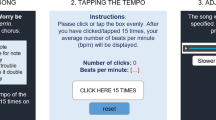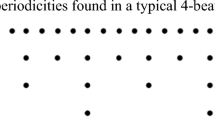Abstract
This study explores tempo stability and accuracy while comparing two subject-response modes: the traditional metronomic pendular adjustment task versus tap-tempo input. Experiment 1 questioned if a single correct tempo measurement consistently emerges from repeated listenings, and if subject-response mode affects tempo stability and accuracy. Experiment 2 assessed incremental improvement between two repeated sessions, and questioned the incidence of self-pacing or congruent effects of potential delays on tempo responses. While single-session studies have shown that listeners find some tempos more enjoyable, can notice discrete differences in pace, and can remember rhythmic speed over prolonged periods of time, the current study employs a multiple-session format focusing on two diametrically opposed subject-response modes. The findings show that tempo responses by listeners without formal music training were consistent across listening sessions, and that responses from tap-tempo input were significantly more stable and accurate than responses from metronomic pendular adjustment tasks.


Similar content being viewed by others
References
Andress BL, Heimann HM, Rinehart CA, Talbert EG (1979) Music in early childhood. MENC, Reston
Behne KE (1972) Der Einfluß des Tempos auf die Beurteilung von Musik (The influence of tempo on the judgment of music). Arno Volk, Köln
Boltz MG (1998) Tempo discrimination of musical patterns: effects due to pitch and rhythmic structure. Percept Psychophys 60:1357–1375
Bowen JA (1999) Finding the music in musicology: performance history and musical works. In: Cook N, Everest M (eds) Rethinking music, chap 19. Oxford University Press, Oxford, pp 424–451
Brodsky W (2002) The effects of music tempo on simulated driving performance and vehicular control. Transport Res F 4:219–241
Brown P (1979) An enquiry into the origins and nature of tempo behaviour. Psychol Music 7:19–35
Dowling WJ, Harwood DL (1986) Rhythm and the perception of time. In: Music cognition, chap 7. Academic, Orlando, pp 178–201
Drake C, Botte MC (1993) Tempo sensitivity in auditory sequences: evidence for a multiple-look model. Percept Psychophys 54:277–286
Drake C, Penel A, Bigand E, Stefan L (1997) Tapping in time with musical and mechanical sequences. In: Gabrielsson A (ed) Proceedings of the 3rd Triennial ESCOM Conference. Department of Psychology, Uppsala University, Uppsala, pp 286–291
Drake C, Penel A, Bigand E (2000) Why musicians tap slower than nonmusicians. In: Desain P, Windsor L (eds) Rhythm perception and production. Swets and Zeitlinger, Lisse, pp 245–248
Ellis MC (1991) Thresholds for detecting tempo change. Psychol Music 19:164–169
Farnsworth P, Block H, Waterman W (1934) Absolute tempo. J Gen Psychol 10:230–233
Franek M, Mates J (1997) Tempo modulation task. In: Gabrielsson A (ed) Proceedings of the 3rd Triennial ESCOM Conference. Department of Psychology, Uppsala University, Uppsala, pp 298–301
Franek M, Mates J, Nartova M (1998) Doubling and halving of tempo: factors influencing preciseness of the performance. In: Yi SW (ed) Proceedings of the 5th international conference on music perception and cognition. Seoul National University, Seoul, pp 359–363
Franek M, Mates J, Nartova M (2000) Tempo change: timing of simple temporal ratios. In: Desain P, Windsor L (eds) Rhythm perception and production. Swets and Zeitlinger, Lisse, pp 143–156
Frischeisen-Kohler I (1933) The personal tempo and its inheritance. Character Pers 1:301–313
Gabrielsson A (1988) Timing in music performance and its relationship to music experience. In: Sloboda JA (ed) Generative processes of music: the psychology of performance, improvisation, and composition. Oxford University Press, Oxford, pp 27–31
Geringer JM (1987) Pitch and tempo preferences in recorded popular music. In: Madsen CK, Pricket CA (eds) Applications of research in music behavior. University of Alabama Press, Tuscaloosa, pp 204–212
Geringer JM, Madsen CK (1984) Pitch and tempo discrimination in recorded orchestral music among musicians and non-musicians. J Res Music Educ 3:195–204
Greenberg M (1979) Your children need music. Prentice Hall, Englewood Cliffs
Halpern AR (1988) Perceived and imagined tempos of familiar songs. Music Percept 6:193–202
Handel S (1993) The effect of tempo and tone duration on rhythmic discrimination. Percept Psychophys 54:370–382
Hargreaves DJ (1986) The developmental psychology of music. Cambridge University Press, Cambridge
Harrison R (1941) Personal tempo. J Gen Psychol 24, 25:343–379
Hevner K (1937) The affective value of pitch and tempo in music. Am J Psychol 49:621–630
Hindemith P (1949) Elementary training for musicians, 2nd revised edn. Schott, London
Hirsch IJ, Bilger RC, Deathrage BH (1956) The effect of auditory and visual background on apparent duration. Am J Psychol 69:561–574
Honing H (2001) From time to time: the representation of timing and tempo. Comput Music J 25:50–61
Johnson P (2002) The legacy of recordings, chap 14. In: Rink J (ed) Musical performance: a guide to understanding. Cambridge University Press, Cambridge, pp 197–212
Jones MR, Yee W (1997) Sensitivity to time change: the role of context and skill. J Exp Psychol P 23:693–709
Karpinski GS (2000) Aural skills acquisition. Oxford University Press, Oxford
Kellaris JJ, Altsech MB (1992) The experience of time as a function of musical loudness and gender of listener. Adv Consumer Res 19:725–729
Kellaris JJ, Rice RC (1993) The influence of tempo, loudness, and gender on listening responses to music. Psychol Market 10:15–29
Kellaris JJ, Mantel SP, Altsech MB (1996) Decibels, disposition and duration: impact of musical loudness and internal states on tempo perceptions. Adv Consumer Res 23:498–503
Kuhn TL (1974) Discrimination of modulated beat tempo by professional musicians. J Res Music Educ 22:270–277
Kuhn TL (1987) The effect of tempo, meter, and melodic complexity on the perception of tempo. In: Madsen CK, Pricket CA (eds) Applications of research in music behavior. University of Alabama Press, Tuscaloosa, pp 165–174
Lapidaki E (2000) Stability of tempo perception in music listening. Music Educ Res 2:25–44
Lapidaki E, Webster PR (1991) Consistency of tempo judgments when listening to music of different styles. Psychomusicology 10:19–30
LeBlanc A (1981) Effects of style, tempo, and performing medium on children’s preference. J Res Music Educ 29:143–156
Leblanc A, McCrary J (1983) Effect of tempo on children’s music preference. J Res Music Educ 31:283–294
Levitin DJ, Cook PR (1996) Memory for musical tempo: additional evidence that auditory memory is absolute. Percept Psychophys 58:927–935
Madsen CK (1979) Modulated beat discrimination among musicians and nonmusicians. J Res Music Educ 27:57–67
Malbran S (2002) Tapping in time: a longitudinal study at the ages of three to five years. Bull Counc Res Music Educ 153(4):71–77
McAuley JD, Semple P (1999) The effect of tempo and musical experience on perceived beat. Aust J Psychol 51:176–187
Povel DJ (1981) The internal representation of simple temporal patterns. J Exp Psychol P 7:3–18
Reed R (2002) How precise and stable is our conception of tempo in music. In: Stevens C, Burnham D, McPherson G, Schuber E, Renwick J (eds) Proceedings of the 7th International Conference on Music perception and cognition. Casual Productions, Adelaide, pp 584–587
Rimoldi HJA (1951) Personal tempo. J Abnorm Soc Psychol 46:280–303
Scholes PA (1972) The Oxford companion to music (10th revised edition, edited by JO Ward). Oxford University Press, London
Shaffer L (1982) Rhythm and timing skill. Psychol Rev 89:109–121
Sims WL (1987) Effect of tempo on music preference of preschool through fourth-grade children. In: Madsen CK, Pricket CA (eds) Applications of research in music behavior. University of Alabama Press, Tuscaloosa, pp 15–25
Starer R (1969) Rhythmic training. MCA Music, New York
Temperley D (2001) The cognition of basic musical structures. MIT Press, Cambridge
Vos PG, Van Assen MA, Franek M (1997) Perceived tempo change is dependent on base tempo and direction of change: evidence for a generalized version of Schulze’s (1978) internal beat model. Psychol Res 59:240–247
Wallin J (1911a) Experimental studies of rhythm and time (Part I). Psychol Rev 18:100–133
Wallin J (1911b) Experimental studies of rhythm and time (Part II). Psychol Rev 18:202–222
Wang CC, Salzberg RS (1984) Discrimination of modulated music tempo by string students. J Res Music Educ 32:123–131
Wapnick J (1980) The perception of musical and metronomic tempo change in musicians. Psychol Music 8:3–12
Wapnick J (1987) A comparison of tempo selections by professional editors, pianists, and harpsichordists in Bach’s Well-Tempered Clavier, Book I. In: Madsen CK, Pricket CA (eds) Applications of research in music behavior. University of Alabama Press, Tuscaloosa, pp 190–212
Wohlschlager A, Koch R (2000) Synchronization error: an error in time perception. In: Desain P, Windsor L (eds) Rhythm perception and production. Swets and Zeitlinger, Lisse, pp 115–128
Wolfe DE (1983) The effect of music loudness on task performance and self report of college-aged students. J Res Music Educ 31:191–201
Woodrow H (1951) Time perception. In: Stevens SS (ed) Handbook of experimental psychology. Wiley, New York, pp 1224–1236
Yarbrough C (1987) The effect of musical excerpts on tempo discriminations and preferences of musicians and nonmusicians. In: Madsen CK, Pricket CA (eds) Applications of research in music behavior. University of Alabama Press, Tuscaloosa, pp 175–189
Yoner S, Yamda M (1998) Temporal control in repetitive tapping of simple rhythmic patterns. In: Yi SW (ed) Proceedings of the 5th International Conference on Music perception and cognition. Seoul National University, Seoul, pp 139–144
Zimmerman MP (1971) Musical characteristics of children. MENC, Reston
Author information
Authors and Affiliations
Corresponding author
Rights and permissions
About this article
Cite this article
Brodsky, W. The effects of metronomic pendular adjustment versus tap-tempo input on the stability and accuracy of tempo perception. Cogn Process 6, 117–127 (2005). https://doi.org/10.1007/s10339-004-0037-8
Received:
Revised:
Accepted:
Published:
Issue Date:
DOI: https://doi.org/10.1007/s10339-004-0037-8




